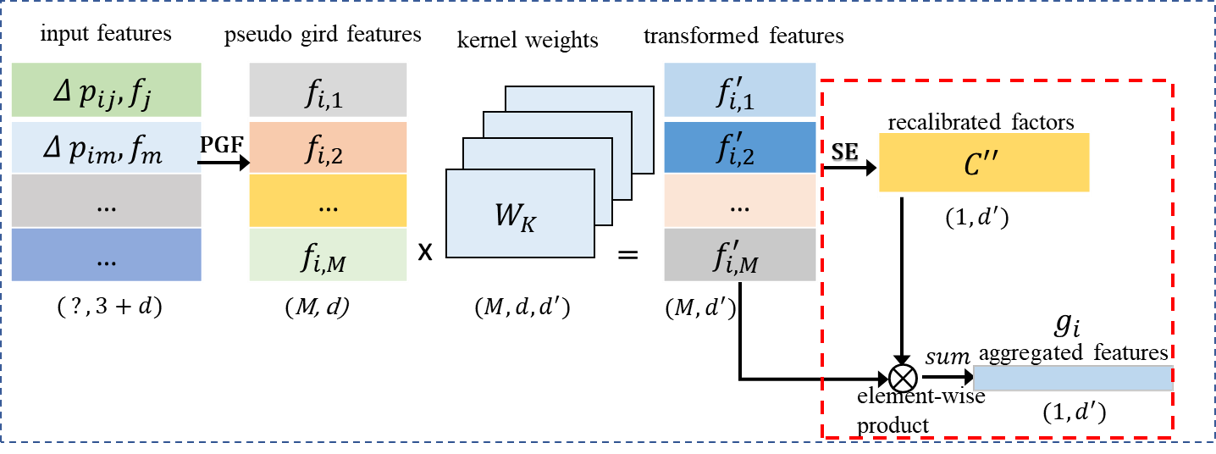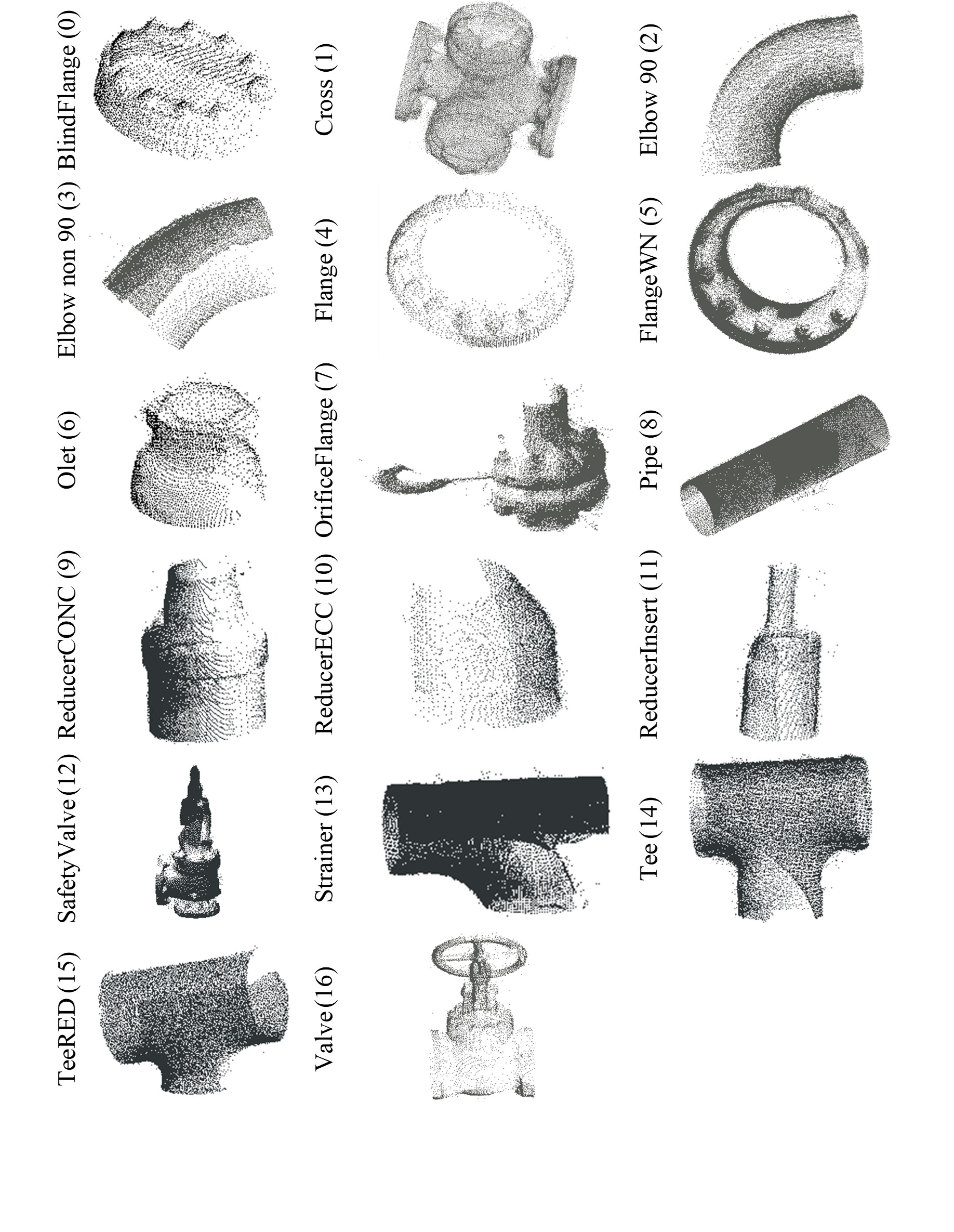This repository is an official implementation of our new paper Automated Classification of Piping Components from 3D LiDAR Point Clouds using SE-PseudoGrid, published in the Automation in Construction journal and its early short version will also appear in the IPC2022 conference in early July. (For free access, you may also read our AutoCon journal paper in the ResearchGate.)
In this study, we proposed a novel local aggregation operator(LAO) based the squeeze-and-excite mechanism from the popular SENet in 2D image analysis (termed SE-LAO) for point cloud feature learning. On top of the newly proposed SE-LAO and the strong PseudoGrid, we construct a new network for piping component classification (named SE-PseudoGrid). To the best of our knowledge, it is the first attempt to generalize the squeeze-and-excite mechanism for 2D image analysis to 3D point cloud analysis. With this new design in the local aggreation operators for point clouds, our SE-PseudoGrid outpeforms the strong baseline PseudoGrid by a large margin on the piping benchmark datast(Pipework).
- the original LAO in the PseudoGrid (reproduced based on the CloserLook3D paper)
- our novel SE-LAO based on the LAO (in PseudoGrid) and squeeze-and-excite mechanism
To install requirements:
#!/bin/bash
ENV_NAME='se'
conda create –n $ENV_NAME python=3.6.10 -y
source activate $ENV_NAME
conda install -c anaconda pillow=6.2 -y
conda install pytorch==1.4.0 torchvision==0.5.0 cudatoolkit=10.1 -c pytorch -y
conda install -c conda-forge opencv -y
pip3 install termcolor tensorboard h5py easydict
Note that: the latest codes are tested on two Ubuntu settings:
- Ubuntu 18.04, Nvidia 3090, CUDA 11.3, PyTorch 1.4 and Python 3.6
sh init.shWe select the sole piping dataset i.e., Pipework (shown below) as the benchmark and canonicalize it following ModelNet40' pratice. The canonicalized dataset can be downloaded from Pipework dataset. Note that the detailed preprocessing steps are shown in the pipework-prepare-v2.ipynb.
typical instances for the 17 categories in the Pipework
train and test set distribution of the new Pipework dataset# download the pipework dataset
unzip pipework-new.zip
cd pipework-new
# move the pipe-original to the root/data folder
# or symlink to the root/data folder
The file structure should look like:
<root>
├── cfgs
│ └── s3dis
├── data
│ └── Pipework
│ └── PipeWork-original
│ ├── BlindFlange
│ ├── Cross
│ └── ...
├── init.sh
├── datasets
├── function
├── models
├── ops
└── utils
To train the model(s) in the paper, run this command:
python -m torch.distributed.launch \
--master_port ${port_number} \ # 12346
--nproc_per_node ${NUM_GPUs} \ # e.g., 1
function/train_pipework_dist.py \
--cfg cfgs/pipework/${yaml_file} \ # e.g., cfgs/pipework/xxx.yaml
--num_points ${num_points} \
--val_freq 10 \
--save_freq 50 \
--loss ${LOSS} \ # e.g., smooth
--use_avg_max_pool ${use_avg_max_pool} # e.g., true
To evaluate my model on ImageNet, run:
python -m torch.distributed.launch \
--master_port ${port_number} \ # 12346
--nproc_per_node ${NUM_GPUs} \
--local_rank 1 \
function/evaluate_pipework_dist.py \
--load_path ${checkpoint_path} \ # e.g., log/pipework/xxx/best.pth
--cfg ${cfg_path} \ # e.g., cfgs/pipework/xxx.yaml
--data_aug ${data_aug} \ # e.g., true or false
--loss ${LOSS} \ # e.g., smooth
--use_avg_max_pool ${use_avg_max_pool} # e.g., true
You can download pretrained models here:
- TOADD trained on the Pipework
- We benchmark six shortlisted representatative DL-based methods on the Pipework.
- On top of our newly proposed SE-LAO and the strong baseline PseduoGrid, we construct our SE-PseudoGrid; It achieves better performance than the baseline, decreasing OA and avgAcc error rate of the backbone by 25.4%, 34.5%, respectively.
| Network | OA (%) | avgAcc (%) |
|---|---|---|
| PointNet | 84.15 | 73.95 |
| PointNet++ | 86.87 | 75.30 |
| DGCNN | 90.90 | 77.16 |
| PointCNN | 91.05 | 88.68 |
| PosPool | 94.33 | 93.61 |
| PseudoGrid | 94.97 | 96.24 |
| SE-PseudoGrid (ours) | 96.25 | 97.54 |
Our pytorch codes borrowed a lot from CloserLook3D and the custom trilinear interoplation CUDA ops are modified from erikwijmans's Pointnet2_PyTorch.
Besides, thanks Prof. Duhwan Mun group to provide the open PipeWork dataset.
MIT license
If you find our work useful in your research, please consider citing:
@article{se-pseudogrid,
Author = {Chao Yin, Jack CP Cheng*, Boyu Wang, Vincent JL Gan*},
Title = {Automated Classification of Piping Components from 3D LiDAR Point Clouds using SE-PseudoGrid},
Journal = {Automation in Construction},
Year = {2022}
}




